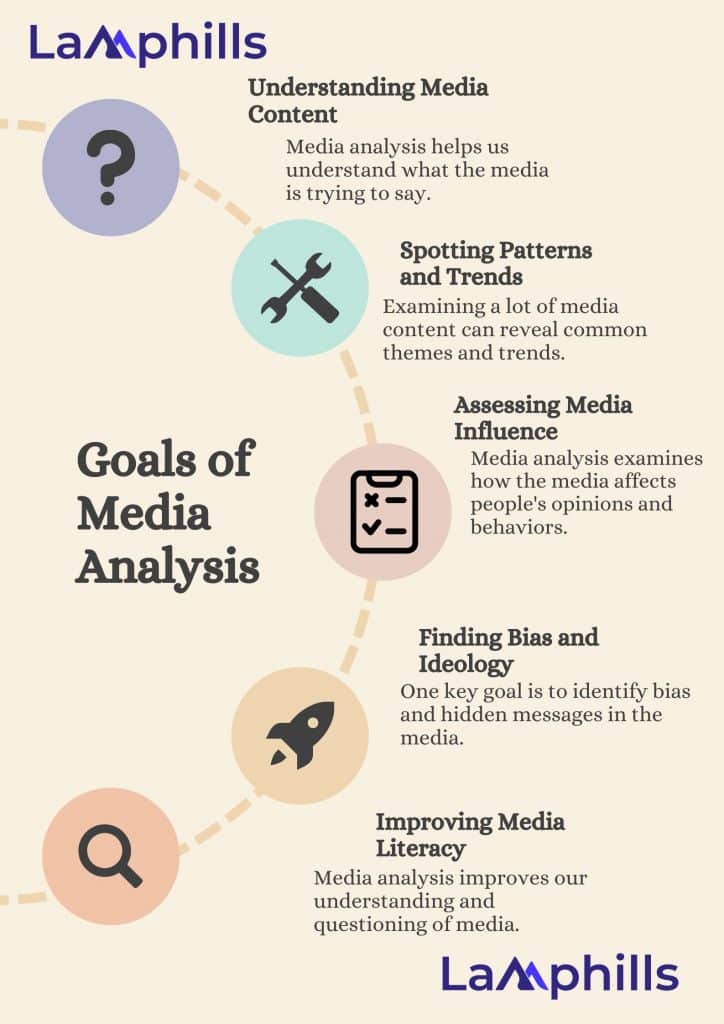

Sometimes, I wonder why some advertisements or news stories stick with us while others fade away. It all comes down to my understanding of the intricate world of media analysis. You might be asking, “What is media analysis, and why is it so important?” Let’s uncover the secrets behind the screens, the definitions, techniques, and types, and how to write media analysis. Let’s get started!
Media analysis plays a critical role in developing a solid marketing strategy. To fully comprehend its importance. Let’s define it and discuss its significance to business success.
Media analysis has a long history, and Harold Lasswell introduced the term “media content analysis” in 1927. Initially, it was a methodical approach to studying mass media, primarily the press, television, and radio. Over time, media monitoring has become a complex strategy that includes an extensive analysis of digital content, such as websites, social media, and visual content.
Marketers have been conducting media analysis for years. However, in the past, they had to manually search for brand mentions, which took up a significant amount of their time. In today’s world, where information overload and millions of websites exist, it would be impossible to manually search and analyze the media each company mentions. That’s why automation of media analysis has become an essential part of the process.
Social media analysis involves collecting and analyzing information from social networks to help make better business choices. It also allows organizations to check their performance based on those decisions by looking at social media outcomes. This process will help you understand what people say and feel about your brand or products. You can use this insight to improve your strategies and engage your audience more effectively.
Let me share some personal insights on the definitions and techniques of media analysis. Media analysis involves studying how media content affects our perceptions and behaviors. It includes looking at everything from news articles to social media posts, focusing on the words, images, and symbols used.
One essential technique is quantitative analysis, where we measure the number of times a brand is mentioned or how often a specific topic appears. This helps us see trends and patterns. For example, by counting how many times a product is mentioned in different media outlets, we can understand its popularity and reach.
Another essential technique is qualitative analysis, where we interpret the deeper meaning behind the media content. This involves examining the context and the subtle messages that might not be immediately obvious. For instance, analyzing a commercial’s underlying messages about gender roles or societal values can reveal much about its impact and intentions.
Combining these techniques provides a well-rounded understanding of media content. For instance, I once analyzed a famous commercial that seemed straightforward but had hidden messages about gender roles and consumer culture. This deeper understanding changed how I viewed that commercial and all media content.
Media analysis is a powerful tool that helps us see beyond the surface and understand the actual influence of media. It’s like having a magnifying glass that reveals the hidden layers of meaning in everything we watch, read, and hear.

Media analysis is incredibly valuable for businesses and other types of organizations. It plays a crucial role in offering strategic insights not only into your own media coverage but also into that of your competitors. Doing so helps you better understand the landscape you’re operating in. Additionally, it evaluates the effectiveness of your relationships with the media. This is key to ensuring that your communications strategy works as intended and that your intended audience receives and understands your messages.
Furthermore, media analysis can assess how to impact your key messages. This means it checks whether the messages you’re sending out resonate with your audience and achieve the desired effect. Overall, media analysis provides a comprehensive view of your position in the media landscape, enabling you to make informed decisions and strategic adjustments to your communication plans.
If you’re curious about the media’s influence and want to understand it better, stick with me.
Understanding the types used for analyzing media is crucial. It’s not something to be done randomly. First, examine how news about your products or services has been covered. What’s being said about your industry? This information is important for your analysis.
The key methods are:
Each has its advantages and disadvantages. Quantitative analysis is all about numbers. It involves tracking how often something of interest is mentioned. This method includes looking at:
Qualitative analysis, however, focuses on the connection between the message and its intended audience. It tries to understand the context of the message. This approach interprets what the media, across different platforms, is trying to communicate to the public. A thorough media analysis should use both methods to be reliable.
Media analysis is detailed and vital for any business looking to stand out. While market research has been the focus for many years, the value of media analytics is becoming more recognized. So, it’s important not to fall behind your competitors in this area.
Let me share with you the 3 parts of how you can write a media analysis:

List all of the media outlets in your area. Include newspapers, news websites, radio stations, television news shows, and any other media outlets you want to include. Depending on the story you hope to share and its scope, you may extend your search to include statewide and national media outlets.
Make a list of search terms based on your topic. Identify the key terms that will help you gather articles about pic. This will help streamline your research by giving you terms to plug into each media channel you investigate.
Use the key terms to find articles on your topic in databases, such as subscription resources like Lexis Nexis and Ebsco Host or free resources like Google Scholar. Plan to go back about six months and collect between 100-200 articles if you’re doing a professional media analysis.
Separate the stories into categories and eliminate irrelevant data. You’ll likely collect three main categories: opinion, news, and feature stories. Eliminate obituaries, calendar items, and any other extraneous items from the data you collect.
Read the articles and underline or take notes. This will make it easier for you to write about your findings. Use a pen or highlighter to note important information in print articles, or note this information if you’re reading digital media or examining T.V. or radio sources. Some things to watch for as you review the media you’ve collected include:
Tip: The length of the story helps you determine its importance. For example, if a short story appears on one page, the news outlet may deem it less necessary than something that takes up multiple pages.
A significant part of the analysis is asking questions and answering them based on the evidence you find in your sources. Some questions you might consider as you review the sources you’ve gathered include:
Summarize what you have learned. After completing your media analysis, summarize what you have learned about how the media covers your subject. Include your answers to all your questions about the data you collected. Note anything of particular importance or that you’re still unsure about.
Identify ways this may help you introduce your own story. A media analysis is a helpful way to determine how best to introduce a story into the media. Consider what you’ve learned and decide if any strategies may help to get your story out to a broader audience or make it more appealing to readers.

Media analysis is all about understanding and evaluating what we see, hear, and read in the media. Let’s break down the main goals of media analysis in simple terms:
Don’t let your brand’s story go unheard. Partner with LampHills and unlock the power of strategic media relations.Get Started Now